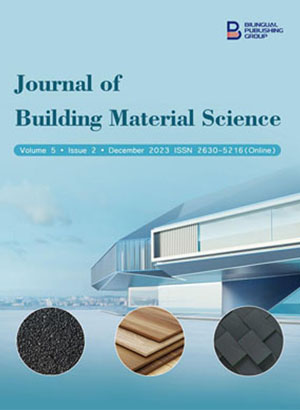
Matrix-Material Fabrication Technique and Thermogravimetric Analysis of Banana Fiber Reinforced Polypropylene Composites
DOI:
https://doi.org/10.30564/jbms.v5i2.5700Abstract
From the environmental consideration, it would be very interesting to use natural fibers such as banana, jute or coir as reinforcement materials instead of artificial fibers or any kind of synthetic materials. Natural fibers have many advantages over synthetic ones. Polypropylene banana fiber composites (PPBC) are prepared using untreated and alkalitreated banana fibers at 10–25% by weight of the fiber loading. The thermal properties of polypropylene natural fiber composites are very important for technological uses. Thermogravimetric measurements show that the incorporation of banana fiber into PP enhances the thermal stability of composites containing treated fibers, in comparison with untreated fibers. A composite of biodegradable polypropylene (PP) reinforced with short banana natural fibers was prepared by melt blending followed by a hot press molding system. The thermal properties of matrix materials were studied using thermogravimetric analyzers TGA units. It is observed that the introduction of short banana fibers slightly improved the thermo oxidative stability of PP-banana composites. Physical and chemical changes occurred through dehydration, phase transition, molecular orientation, crystallinity disruption, oxidation and decomposition, and incorporation of several functional groups. Systematic investigations of the thermal behavior of polymers in gas, vacuum or inert atmosphere give the knowledge of how change takes place in polymers. To understand such changes thermogravimetric analysis (TGA) and thermal analysis (TG) were performed. It is observed reinforcement of short banana fiber leads to little improvement in the thermooxidative stability of PPBC. Due to the enhancement of thermo-mechanical properties, such composites may be used as building materials namely roof materials, selling materials and many other engineering applications.
Keywords:
Polypropylene banana composites (PPBC); Natural fiber; Oxidative stability; Thermogravimetric analysis(TGA); DecompositionReferences
[1] Keattch, C.J., Dollimore, D., 1969. An introduction to thermogravimetry. Heyden & Son Ltd.: New York.
[2] Hatakeyama, T., Quinn, F.X., 1999. Thermalanalysis: Fundamentals and applications to polymer science. John Wiley & Sons Ltd.: London.
[3] Katsikas, L., Jeremic, K., Jovanovic, S., et al.,1993. The thermal degradation kinetics of dextran and pullulan. Journal of Thermal Analysisand Calorimetry. 40(2), 511–517.
[4] Eroğlu, M.S., Akilli, M.M., Güven, O., 1997.Spectroscopic, thermal, and mechanical characterization of carboxyl-terminated polybutadiene-based carbon black-filled networks. Journalof Applied Polymer Science. 66(2), 355–366.
[5] Islam, Md. Nazrul, Gafur, M. A. and Khan,Amir Hussain, 2007. Natural fiber-polypropylene (Banana-PP) matrix composites- fabricationand study of mechanical properties: Jahangirnagar Physics Studies, 13, 1–7.
[6] Rajulu, A.V., Rao, G.B., Rao, B.R.P., et al.,2002. Properties of ligno-cellulose fiber Hildegardia. Journal of Applied Polymer Science.84(12), 2216–2221.
[7] Pal, S.K., Mukhopadhyay, D., Sanyal, S.K.,et al., 1988. Studies on process variables for natural fiber composites-effect of polyesteramidepolyol as interfacial agent. Journal of AppliedPolymer Science. 35(4), 973–985.
[8] Rana, A.K., Basak, R.K., Mitra, B.C., et al.,1997. Studies of acetylation of jute using simplified procedure and its characterization. Journalof Applied Polymer Science. 64(8), 1517–1523.
[9] Mitra, B.C., Basak, R.K., Sarkar, M., 1998.Studies on jute-reinforced composites, its limitations, and some solutions through chemicalmodifications of fibers. Journal of Applied Polymer Science. 67(6), 1093–1100.
[10] Guha Roy, T.K., Chatterjee, S., Adhikari, D.,et al., 1988. Studies on the bleaching of jute.Journal of the Textile Institute. 79(1), 108–125.
[11] Liaw, D.J., Lee, W.F., 1985. Thermal degradation of poly [3-dimethyl (methylmethacryloylethyl) ammonium propanesulfonate]. Journal of Applied Polymer Science. 30(12), 4697–4706.
[12] Lee, W.F., 1989. Comparative study of variousmethods for thermal degradation of poly [3-dimethyl (methacryloyloxyethyl) ammoniumpropanesulfonate]. Journal of Applied PolymerScience. 37(11), 3263–3275.
[13] Lee, W.F., Tsai, C.C., 1994. Aqueous solutionproperties of poly (trimethyl acrylamido propyl ammonium iodide) [poly (TMAAI)]. Journal ofApplied Polymer Science. 52(10), 1447–1458.
[14] Niehuis, E., Heller, T., Feld, H., et al., 1987. Design and performance of a reflectron based timeof-flight secondary ion mass spectrometer withelectrodynamic primary ion mass separation.Journal of Vacuum Science & Technology A:Vacuum, Surfaces, and Films. 5(4), 1243–1246.
[15] Chand, N., Vashishtha, S.R., 2000. Development, structure and strength properties of PP/PMMA/FA blends. Bulletin of Materials Science. 23, 103–107.
[16] Ray, D., Sarkar, B.K., Rana, A.K., et al., 2001.The mechanical properties of vinylester resinmatrix composites reinforced with alkali-treatedjute fibres. Composites Part A: Applied Scienceand Manufacturing. 32(1), 119–127.
Downloads
How to Cite
Issue
Article Type
License
Copyright © 2023 Nazrul Islam, M. A Gafur

This is an open access article under the Creative Commons Attribution-NonCommercial 4.0 International (CC BY-NC 4.0) License.







 Nazrul Islam
Nazrul Islam






